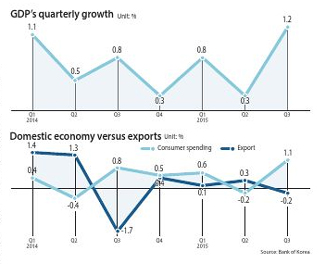Economy reaches five-year high

However, exports, a crucial pillar of Korea’s economy, continued to struggle.
Korea’s GDP in the July-September period grew 1.2 percent compared to the first three months of the year, according to the Bank of Korea (BOK) on Friday. When compared to a year ago, the economy expanded 2.6 percent.
This is the first time that the economy has reported growth of more than 1 percent since the first quarter of 2014 when it grew 1.1 percent compared to the last three months of 2013.
Economic growth has remained below 1 percent since the second quarter of 2014, which was heavily impacted by the Sewol ferry tragedy that killed 300 passengers, mostly high school students on a spring trip to Jeju Island.
But most noticeable is that third quarter quarterly growth saw the sharpest expansion the Korean economy has seen since the second quarter of 2010, when it grew 1.7 percent.
The turnaround from the 0.3 percent growth in the second quarter to expand more than 1 percent was largely attributed to improvement in the domestic market.
BOK governor Lee Ju-yeol earlier this month said that consumer spending was recovering at a rapid pace.
“The fear over Middle East respiratory syndrome (MERS) has stabilized and government policies, such as lowering the special consumption tax and Black Friday, further helped the recovery of spending in the private sector,” Lee said.
Consumer spending saw a 1.1 percent increase compared to the second quarter. This is a sharp turnaround from the 0.2 percent quarterly decline reported in the second quarter largely due to the fear spread by MERs.
Government spending also helped the recovery of the domestic market as it grew 1.9 percent, twice the second quarter growth of 0.8 percent. The impact of MERS was especially visible
in the improvement of the service
industry.
While the manufacturing industry in the third quarter actually saw its growth decelerate from 1.2 percent in the second quarter to 0.1 percent, the service industry grew 5.3 percent. This is a significant improvement from a 0 percent growth in the second quarter.
“In the third quarter the negative influences caused by MERS have subsided,” said Jeon Seung-cheol, director general of economic statistics department at the central bank. “The service industry including retail and wholesale, lodging, health and welfare and logistics that were affected by MERS grew.”
The construction industry’s growth has also helped the domestic market. Thanks to a more active property market that led to more apartment construction as well as increased government infrastructure investments resulting from the supplementary budget, the construction industry’s investments grew 4.5 percent in the third quarter, which is an improvement from the 1.6 percent quarterly growth reported during the March-June
period.
As a result the construction industry expanded nearly 8 percent, a sharp expansion from 0 percent in the second quarter and a turnaround from the first quarter when it declined 3.5 percent.
Although the economy in the third quarter saw an improvement, it needs to register a 0.9 percent growth in the fourth quarter in order to achieve the 2.7 percent growth target set by the central bank. The Bank of Korea earlier this month revised its outlook for this year’s growth from 2.8 percent set in July to 2.7 percent.
One of the biggest obstacles is struggling exports, caused by the slowing economic growth in China, which saw its third quarter decelerate to the lowest since the first quarter of 2009. In fact outbound shipments in the third quarter declined 0.2 percent. It was the first quarterly decline after falling 1.7 percent in the third quarter in 2014.
“Major export products such as LCDs, petrochemicals and shipbuilding are slowing down,” said BOK official Jeon. “As the external conditions are unfavorable, it is difficult to expect a substantial improvement [in exports] in the fourth quarter.”
BOK Governor Lee also raised concerns about the global economy and its potential impact on the Korean economic recovery during a joint conference hosted by the central bank and Yonsei University on Friday.
“The global financial market is showing frequent insecurity due to the G-2 (China and U.S.) risk and uncertainty regarding the direction of global growth,” said the BOK governor. He said anxiety over the U.S. interest rate hike and the slowing Chinese economy could result in instability of financial markets in emerging markets including Korea and affect economic recovery.
“We’re in a situation where we have to rely on the domestic economy as exports will likely continue to struggle,” said Lim Hee-jung, a senior researcher at Hyundai Research Institute. “But it won’t be easy to achieve
a 0.9 percent growth in the fourth quarter.”
BY LEE HO-JEONG [lee.hojeong@joongang.co.kr]










with the Korea JoongAng Daily
To write comments, please log in to one of the accounts.
Standards Board Policy (0/250자)